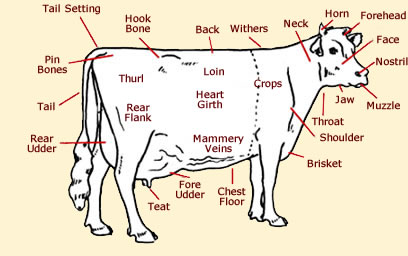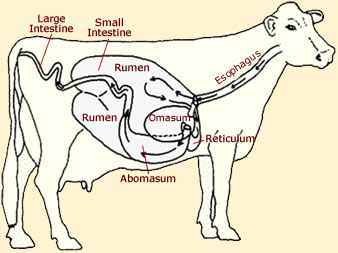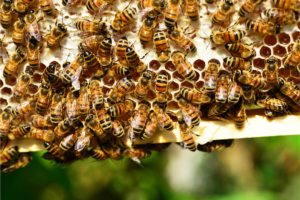Cattle, often referred to as bovines, play a vital role in our world, providing essential resources like meat, milk, and leather. To truly appreciate these remarkable animals and their contributions to human society, it is essential to gain a comprehensive understanding of the various parts of a cattle.
From their majestic horns to the sturdy hooves that support their massive frames, the anatomy of cattle is a complex and fascinating subject that has intrigued scholars and farmers for generations. In this article, we will look into the intricate details of a cattle’s anatomy, exploring the different components that make up these magnificent creatures. Whether you’re a livestock enthusiast, a student of biology, or simply curious about the inner workings of these iconic animals, this article will provide valuable insights into the parts of a cattle.
External Parts of a cattle

The external parts of a cattle includes the following;
- Horns
- Hooves
- Tail
- Ears
- Eyes
- Nostrils
- Muzzle
- Dewlap
- Forehead
- Humps
- Flank
- Crest
- Sheath
- Knee
- Forearm
- Brisket
- Dewclaw
- Back
- Rump
- Hocks
- Pasterns
- Ankles
- Udder (in females)
- Scrotum (in males)
- Teats (in females)
- Vulva (in females)
- Testicles (in males)
Horns
Cattle’s horns are more than just a striking feature; they serve several important functions. These bony protrusions on the heads of both males and females play a crucial role in defense, helping cattle protect themselves and their herd. Additionally, horns aid in grooming and scratching, providing relief from itching or bothersome insects.
Hooves
Cattle’s hooves, like a well-designed pair of shoes, are essential for mobility and support. These hard, cloven hooves help them traverse various terrains, from soft pastures to rocky landscapes. Proper hoof structure is crucial for a cow’s balance and stability. When neglected, hoof issues can lead to lameness, affecting the animal’s overall well-being.
Tail
The tail of a cow is a versatile appendage. Beyond its role in shooing away flies, it serves as a communication tool, allowing cattle to convey their emotions and intentions. Tail position, whether raised in excitement or lowered in distress, provides valuable insight into a cow’s state of mind.
Ears
Cattle’s ears are remarkably perceptive and are finely tuned to detect sounds and movements in their environment. Their rotational ability enables cows to pinpoint the source of a sound swiftly. Additionally, the ears play a role in regulating body temperature. Blood vessels in the ears help dissipate excess heat during hot weather.
Eyes
Cattle have large, expressive eyes that serve as their window to the world. These eyes are essential for situational awareness and predator detection. Cows are capable of panoramic vision, with a nearly 360-degree field of view. This visual acumen helps them detect potential threats and navigate their surroundings safely.
Nostrils
The nostrils of cattle are finely attuned to scent. They use their highly developed sense of smell to locate food, identify other animals, and detect changes in the environment. The ability to detect unfamiliar scents helps cattle remain vigilant against potential dangers.
Muzzle
The muzzle of a cow, or its nose and mouth area, is its primary tool for foraging and feeding. Cattle use their strong, prehensile lips to grasp and tear grass and other vegetation. The rough texture of the tongue aids in breaking down and digesting their food.
Dewlap
The dewlap, often more prominent in females, is a loose flap of skin hanging beneath the neck. While it might seem inconspicuous, it plays a vital role in regulating body temperature. During hot weather, cattle pump warm blood into the dewlap, which acts as a natural radiator, dissipating heat and helping the animal stay cool.
Forehead
The forehead of cattle is not just a blank canvas; it contains key anatomical features. Between the eyes and above the nose, you’ll find the frontal sinuses, which are crucial for cooling the blood and regulating temperature. The prominence of these sinuses contributes to the distinctive shape of a cow’s forehead.
Humps
Humps, a characteristic of some cattle breeds, like the zebu, serve as fat storage reservoirs. These fatty deposits are a valuable energy source in times of scarcity, enabling the animal to survive in arid regions with limited access to food and water.
Flank
The flank of a cow, located on the side of the body, is not just a plain surface. It houses the vital organs, such as the rumen, which plays a central role in the cow’s digestive process. Understanding the flank’s importance is crucial for ensuring the health and well-being of cattle.
Crest
The crest of cattle refers to the top of their neck, and it’s not just a piece of anatomy; it can signify dominance within a herd. A well-developed crest is often associated with higher-ranking individuals, showcasing their status in the social hierarchy.
Sheath
The sheath is a male-specific anatomical feature that houses the penis when not in use. Maintaining the sheath’s cleanliness is essential for the overall health of a bull, as neglect can lead to infections or discomfort.
Knee
Cattle have sturdy, jointed knees that provide support for their weight and enable them to stand, walk, and graze. Understanding the anatomy and function of these joints is crucial for identifying and addressing issues related to mobility and lameness.
Forearm
The forearm of cattle comprises the muscles and bones that are essential for locomotion. A strong and healthy forearm is crucial for a cow’s ability to move and graze effectively. It’s a key component of their overall musculoskeletal system.
Brisket
The brisket of cattle, located in the chest area, contains important respiratory and circulatory structures. A well-developed brisket is a sign of good health and efficient oxygen supply to the body. Understanding its function is vital for monitoring cattle’s well-being.
Dewclaw
Dewclaws, small, vestigial digits on the lower legs of some cattle, have largely lost their function in modern cattle. However, they serve as a reminder of the evolutionary history of these animals. Dewclaws are a fascinating feature to explore from an evolutionary perspective.
Back
The back of cattle plays a crucial role in supporting the weight of the animal and facilitating its posture and mobility. Understanding the structure and function of the back is vital for assessing the overall health and condition of cattle.
Rump
The rump of cattle is a region encompassing the hindquarters and tail. It’s not just a rear end; it contains key muscle groups used for locomotion and reproduction. Proper assessment and care of the rump are essential for the well-being of the animal.
Hocks
Hocks are the equivalent of human ankle joints in cattle. These joints are essential for mobility and locomotion. Understanding the structure and function of hocks is crucial for identifying and addressing issues related to lameness and joint health.
Pasterns
Pasterns are the lower part of the leg between the hoof and the fetlock joint. These flexible structures provide shock absorption during locomotion, protecting the bones and joints from excessive impact.
Ankles
Cattle have ankles, just like humans, but they are positioned higher on the leg. Understanding the function of these joints is essential for assessing the overall mobility and health of the animal.
Udder (in females)
The udder is a vital reproductive and lactation organ in female cattle. It serves as the milk-producing factory, providing essential nourishment to calves. Maintaining udder health is critical for milk production and overall animal welfare.
Scrotum (in males)
The scrotum is a male-specific anatomical feature that houses the testicles. These organs are essential for reproduction, producing sperm and male hormones. Understanding the structure and function of the scrotum is crucial for breeding and managing the male cattle population.
Teats (in females)
Teats are the protruding nipples on the udder of female cattle, and they are the pathway through which milk is delivered to their offspring. Proper care of teats is essential for milk production, as well as preventing infections and ensuring the well-being of both mother and calf.
Vulva (in females)
The vulva is the external genitalia of female cattle, and it plays a crucial role in reproduction. Understanding its anatomy and function is essential for successful breeding and reproductive health management.
Testicles (in males)
Testicles are male reproductive organs responsible for producing sperm and male hormones. Understanding the role of testicles is essential for managing the breeding and reproductive health of male cattle.
Internal parts of a cattle

The internal parts of a cattle includes the following;
- Rumen
- Reticulum
- Omasum
- Abomasum
- Liver
- Gallbladder
- Spleen
- Small intestine
- Large intestine (colon)
- Pancreas
- Heart
- Lungs
- Kidneys
- Bladder
- Uterus (in females)
- Ovaries (in females)
- Testes (in males)
- Prostate gland (in males)
- Epididymis (in males)
- Seminal vesicles (in males)
- Vas deferens (in males)
Rumen
The rumen, the largest of the four stomach compartments in cattle, is a fermentation vat of sorts. Here, microbes work their magic, breaking down fibrous plant material through a process known as fermentation. This complex system allows cattle to derive nutrients from cellulose, a substance that’s indigestible to most animals. Essentially, it’s their own bioreactor for converting roughage into energy. The rumen plays a pivotal role in the cow’s digestive process, turning an herbivorous diet into a powerhouse of nutrition.
Reticulum
The reticulum is the second stomach compartment in cattle, and it’s often called the “hardware stomach” because it’s responsible for trapping any foreign objects the cow may ingest. These foreign objects can include nails, wire, or other debris. Once captured in the reticulum, these items can cause hardware disease if not removed promptly.
Omasum
The omasum, or “manyplies,” is the third stomach compartment. Here, the partially digested food from the rumen is further broken down and water is absorbed. Think of it as a natural water recycling system that prevents dehydration and ensures optimal nutrient absorption.
Abomasum
The abomasum is the fourth and final stomach compartment and is often compared to a human’s stomach. It’s the primary site for enzymatic digestion, where gastric juices break down food. This compartment is crucial for protein digestion and nutrient absorption.
Liver
The liver, a multitasking organ in cattle, is the powerhouse of metabolic processes. It detoxifies the bloodstream, stores essential nutrients, and produces bile to aid in digestion. A healthy liver is vital for overall cattle health.
Gallbladder
The gallbladder is like a reservoir for bile produced by the liver. It releases bile into the small intestine when needed to emulsify fats, facilitating their digestion and absorption. Without a functioning gallbladder, fat digestion would be compromised.
Spleen
The spleen is an often-underappreciated organ in cattle. It plays a role in blood filtration, removing damaged blood cells and pathogens. Additionally, it acts as a reservoir for red blood cells, releasing them into the bloodstream when needed.
Small Intestine
The small intestine is where the real magic of nutrient absorption occurs. Nutrients from digested food are absorbed into the bloodstream here. It’s a crucial site for ensuring that the energy and building blocks from the cow’s diet are put to good use.
Large Intestine (Colon)
In the large intestine, or colon, water absorption is a key function. It’s where the digestive process concludes, and undigested material is prepared for excretion. Efficient water absorption here is crucial to preventing dehydration.
Pancreas
The pancreas is a vital gland that produces digestive enzymes and regulates blood sugar levels. Its role in maintaining balanced glucose levels is essential for overall metabolic health.
Heart
The heart is the pumping engine of the circulatory system. It propels oxygen-rich blood throughout the body, ensuring that all cells have the resources they need to function.
Lungs
Lungs are the primary organs for respiration, facilitating the exchange of oxygen and carbon dioxide. Proper lung function is critical for maintaining sufficient oxygen levels in the bloodstream.
Kidneys
The kidneys are the body’s filtration system, removing waste products and excess substances from the blood to maintain electrolyte balance and blood pressure. They also produce urine, a means of eliminating these waste products.
Bladder
The bladder is the storage reservoir for urine. It collects and holds urine until it’s expelled from the body, providing a means of waste elimination.
Uterus (in females)
In females, the uterus is the reproductive organ where embryos implant and develop during pregnancy. It plays a crucial role in the reproduction and nurturing of calves.
Ovaries (in females)
The ovaries are the female reproductive glands, producing eggs (ova) and female hormones. They are integral to the reproductive cycle in females.
Testes (in males)
In males, the testes are the male reproductive glands responsible for producing sperm and male hormones, such as testosterone. They are essential for reproduction and the development of secondary sexual characteristics.
Prostate Gland (in males)
The prostate gland in males is part of the reproductive system, producing a portion of the seminal fluid that nourishes and transports sperm during ejaculation.
Epididymis (in males)
The epididymis is a coiled tube in the male reproductive system where sperm mature and gain the ability to swim.
Seminal Vesicles (in males)
Seminal vesicles in males produce a significant portion of the seminal fluid that nourishes and transports sperm.
Vas Deferens (in males)
The vas deferens is a muscular tube that carries sperm from the epididymis to the urethra, where it can be ejaculated during reproduction.
Understanding these internal parts and their functions in cattle is essential for their health, well-being, and efficient management in agriculture.
Read also: Parts of a chicken
The bottom line
In conclusion, the parts of a cattle, both external and internal, form a complex and intricately designed system that enables these remarkable creatures to thrive in a variety of environments. From the utilitarian horns and hooves that help them interact with their surroundings to the intricate digestive system comprising the rumen, reticulum, omasum, and abomasum, each part serves a specific purpose in the cattle’s journey from foraging to nutrition.
FAQs about parts of a cattle
- What is cow innards?: Cow innards, also known as offal, refer to the internal organs of a cow that are often used as food. These may include the heart, liver, kidneys, spleen, and other internal organs. Offal is consumed in various cuisines and is a valuable source of nutrients.
- What is cow tongue called?: The cow’s tongue is commonly referred to as “beef tongue.” It is a muscular organ found in the mouth of cattle. Beef tongue is often used in culinary dishes and is prized for its tender and flavorful meat.
- What is offal or tripe?: Offal, or tripe, is a term that encompasses various edible internal organs of cattle and other animals. These can include the heart, liver, kidneys, stomach lining (tripe), and other visceral organs. Offal is considered a delicacy in many cultures and is used in a wide range of dishes.
- Why is cow tongue black?: The cow’s tongue may appear black or dark in color due to the presence of pigments called melanin. Melanin gives color to skin, hair, and various body parts. The extent of pigmentation can vary among individual animals and breeds. The dark coloration of the cow’s tongue is a natural variation and does not affect the meat’s quality or taste.
